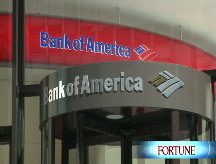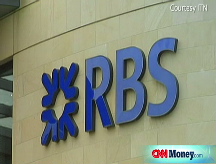Banks likely to head back to the trough
Large financial institutions are expected to need more capital later this year. But after TARP money from the government runs out, where will the cash come from?
NEW YORK (CNNMoney.com) -- Can anything satisfy banks' appetite for capital?
Judging by the way things are going in the sector lately, the answer seems to be a resounding 'No.'
Last week, the government allocated an additional $20 billion for the seemingly steady Bank of America (BAC, Fortune 500) to help the company close its acquisition of Merrill Lynch. BofA has now received $45 billion in government funds as part of the government Troubled Asset Relief Program, or TARP.
And in late November, the government effectively had to double down on its bet in Citigroup (C, Fortune 500) by investing an additional $25 billion in the company to stave off its collapse and prevent broader fallout across the financial system. Citi has also received $45 billion in TARP capital.
So far, $192 billion in government money has been invested in more than 200 financial institutions. But that may not be enough to fix the many problems in the banking sector.
Many large banks are continuing to face massive writedowns tied to the mortgage-related assets on their books that have tumbled in value alongside the broader U.S. housing market.
At the same time, the industry is now entering what some have labeled as one of the most difficult economic climates since the Great Depression. As unemployment climbs, banks are certain to face widespread losses on both consumer and commercial loans. That will only deteriorate banks' capital levels even further.
"At this point [banks] have got enough capital to play through the next round of earnings," said Jason Tyler, a senior vice-president at the Chicago-based Ariel Investments, whose firm oversees about $7 billion in assets.
So what happens after that?
To be sure, banks may be able to get some help from the second half of the government's $700 billion financial rescue package.
But hopes of getting additional government funds has begun to dwindle in recent weeks as both President-elect Barack Obama and fellow Democratic lawmakers have revealed their plans for the remaining TARP funds.
Up to $100 billion is expected to go towards addressing rising foreclosures. That could ease some of the problems that the deteriorating U.S. housing market has been having on banks.
But that also means that there is $100 billion less that is available for any bank facing an immediate need for capital.
Part of the remaining TARP funds are also expected to go towards expanding consumer credit, including expanding a Federal Reserve program tied to boosting the securitization market for mortgages, credit card loans and student loans. That program is scheduled to start next month.
Last week, outgoing Treasury Secretary Henry Paulson indicated that progress was being made towards buying the troubled assets from banks and placing them into a so-called "bad bank" -- the original purpose of the $700 billion legislation.
Such a move, however, could trigger an accounting rule, which could prompt banks to take yet another painful series of writedowns, leaving their capital levels even more depressed.
Banks, which have endured plenty of criticism for failing to specifically use TARP funds to make more loans available to consumers and businesses, are also finding that they are not the only ones competing for TARP funds.
Two of Detroit's Big Three automakers claimed a piece of the first half of TARP in December. Under new legislation proposed by House Financial Services Chairman Barney Frank, D-Mass., the incoming Treasury Secretary could also use money from the bank bailout for areas such as commercial real estate, farming and small business.
If this happens, the banks could be faced with a far smaller portion of TARP funding available to them -- precisely at a time when many banks may need more capital to boost their reserves and prepare for more loans losses.
Regulators, including the Federal Deposit Insurance Corp.'s Chairman Sheila Bair, have suggested publicly in recent days they hope that private investors will step in and provide more banks with capital.
That has happened to some extent. Earlier this month, billionaire investor Wilbur Ross agreed to take a majority stake in the closely held First Bank & Trust of Indiantown, Fla..
But private investors largely remain on the sidelines, hampered by existing regulatory restrictions that limit their investments in depository institutions.
At the same time, a couple high-profile bad bets, most notably a $7 billion investment by private equity giant TPG in Washington Mutual last year, which soured after the company collapsed and was subsequently taken over by JPMorgan Chase (JPM, Fortune 500), have kept many private investors on the sidelines.
Sovereign wealth funds, which invested heavily in the U.S. financial services sector in late 2007 through the spring of last year, have also tightened their purse strings after the value of their investments were virtually wiped out.
"Everyone who has invested in banks to this point has been burned," said Jaime Peters, banking analyst at Morningstar. "How many times are you going to stick your hand in the fire before you learn not to?"
All this means banks may look to other ways to raise capital, such as asset sales.
Citigroup, one of the nation's hardest hit banks during the credit crisis, agreed to sell a majority stake in its Smith Barney brokerage business last week to Morgan Stanley (MS, Fortune 500) in exchange for a $2.7 billion cash payment.
There is also speculation that the company is poised to put its Japanese brokerage business -- Nikko Cordial -- on the auction block as well, the Wall Street Journal reported over the weekend.
But most analysts think banks won't be able to fetch premium prices for any assets sales in this market. So that limits how much capital they can raise by splitting up or getting smaller.
Banks could also move to raise cash by issuing common stock. But analysts note that determining the price of the offering could prove tricky, especially since investors have continued to shun bank stocks this year after a brutal 2008.
Even if banks could find a good price to sell more stock, the banks would probably face a significant backlash from existing shareholders since an increased number of shares on the market would make their investments less valuable.
That's in addition to growing concerns about what might happen if the government had to completely take over a financial institution, as was the case with mortgage financing giants Fannie Mae (FNM, Fortune 500) and Freddie Mac (FRE, Fortune 500). Shares in those two firms are now largely worthless.
"People are worried about banks issuing more common stock," said Ralph Cole, a portfolio manager at Portland, Ore.-based Ferguson Wellman Capital Management. "You worry about getting diluted and having the government take over and wiping out those shareholders as well."
That largely puts some hard-hit banks closer to the very unwelcome position of relying on the government to keep them afloat, said Sam Golden, head of the Financial Industry Advisory Services Group at Alvarez & Marsal and former ombudsman of the Office of the Comptroller of the Currency.
"Do you nationalize the whole system? I hope that is not the complete answer," he said. "But if you look at the trends, the only place where any meaningful source of capital is coming from is the government." ![]()



